
"Eppur si muove!"
***
The Hummingbird Effect: How Galileo Invented Time and Gave Rise to the Modern Tyranny of the Clock
by Maria Popova
How the invisible hand of the clock powered the Industrial Revolution and sparked the Information Age.
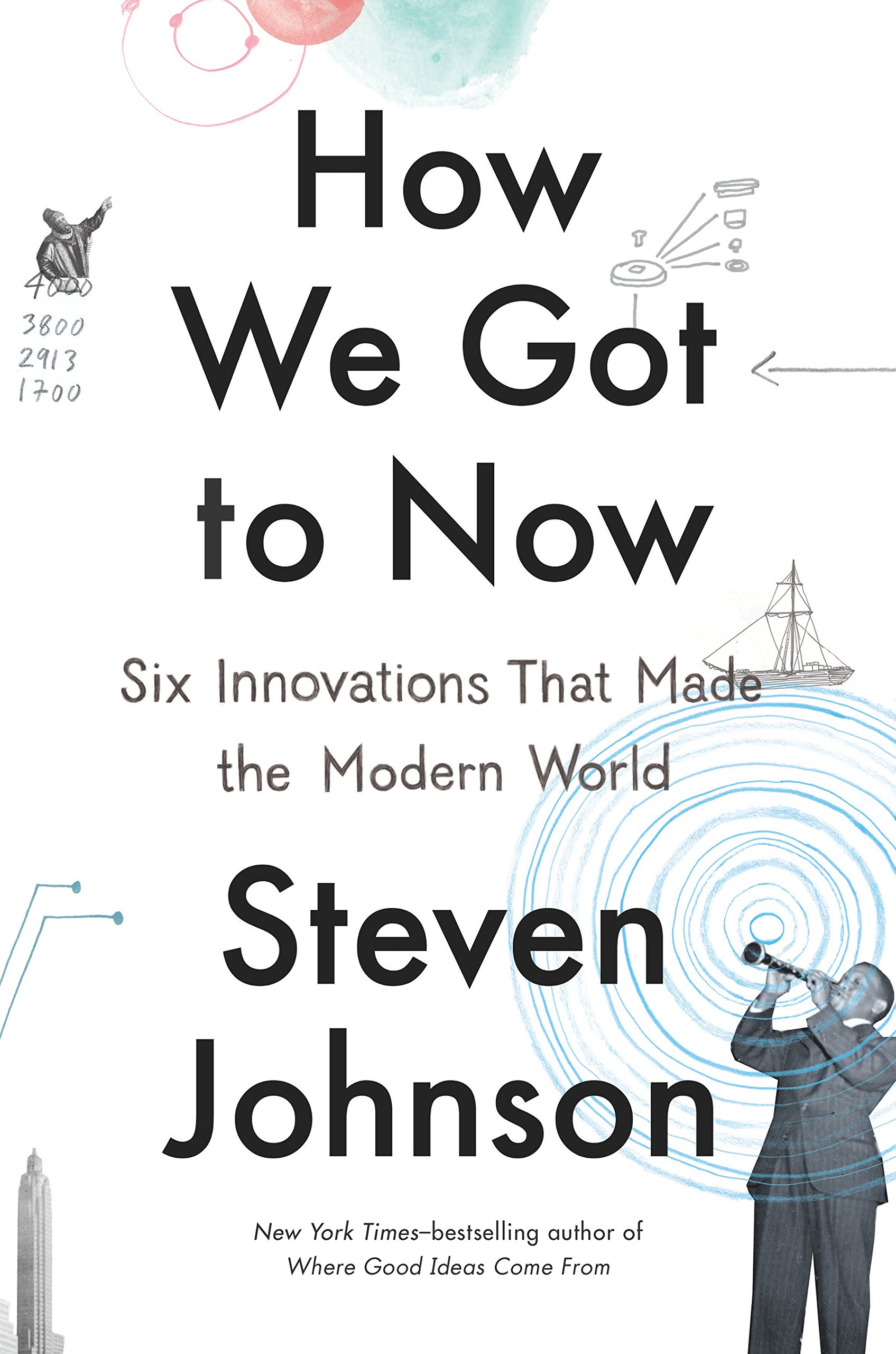 While we appreciate it in the abstract, few of us pause to grasp the miracles of modern life, from artificial light to air conditioning, asSteven Johnson puts it in the excellent How We Got to Now: Six Innovations That Made the Modern World (public library), “how amazing it is that we drink water from a tap and never once worry about dying forty-eight hours later from cholera.” Understanding how these everyday marvels first came to be, then came to be taken for granted, not only allows us to see our familiar world with new eyes — something we are wired not to do — but also lets us appreciate the remarkable creative lineage behind even the most mundane of technologies underpinning modern life. Johnson writes in the introduction:
While we appreciate it in the abstract, few of us pause to grasp the miracles of modern life, from artificial light to air conditioning, asSteven Johnson puts it in the excellent How We Got to Now: Six Innovations That Made the Modern World (public library), “how amazing it is that we drink water from a tap and never once worry about dying forty-eight hours later from cholera.” Understanding how these everyday marvels first came to be, then came to be taken for granted, not only allows us to see our familiar world with new eyes — something we are wired not to do — but also lets us appreciate the remarkable creative lineage behind even the most mundane of technologies underpinning modern life. Johnson writes in the introduction:Our lives are surrounded and supported by a whole class of objects that are enchanted with the ideas and creativity of thousands of people who came before us: inventors and hobbyists and reformers who steadily hacked away at the problem of making artificial light or clean drinking water so that we can enjoy those luxuries today without a second thought, without even thinking of them as luxuries in the first place… We are indebted to those people every bit as much as, if not more than, we are to the kings and conquerors and magnates of traditional history.
Johnson points out that, much like the evolution of bees gave flowers their colors and the evolution of pollen altered the design of the hummingbird’s wings, the most remarkable thing about innovations is the way they precipitate unanticipated changes that reverberate far and wide beyond the field or discipline or problem at the epicenter of the particular innovation. Pointing to the Gutenberg press — itself already an example of the combinatorial nature of creative breakthroughs — Johnson writes:
Johannes Gutenberg’s printing press created a surge in demand for spectacles, as the new practice of reading made Europeans across the continent suddenly realize that they were farsighted; the market demand for spectacles encouraged a growing number of people to produce and experiment with lenses, which led to the invention of the microscope, which shortly thereafter enabled us to perceive that our bodies were made up of microscopic cells. You wouldn’t think that printing technology would have anything to do with the expansion of our vision down to the cellular scale, just as you wouldn’t have thought that the evolution of pollen would alter the design of a hummingbird’s wing. But that is the way change happens.
Johnson terms these complex chains of influences the “hummingbird effect,” named after the famous “butterfly effect” concept from chaos theory — Edward Lorenz’s famous metaphor for the idea that a change as imperceptible as the flap of a butterfly’s wings can result in an effect as grand as a hurricane far away several weeks later — but different in a fundamental way:
The extraordinary (and unsettling) property of the butterfly effect is that it involves a virtually unknowable chain of causality; you can’t map the link between the air molecules bouncing around the butterfly and the storm system brewing in the Atlantic. They may be connected, because everything is connected on some level, but it is beyond our capacity to parse those connections or, even harder, to predict them in advance. But something very different is at work with the flower and the hummingbird: while they are very different organisms, with very different needs and aptitudes, not to mention basic biological systems, the flower clearly influences the hummingbird’s physiognomy in direct, intelligible ways.
Under the “hummingbird effect,” an innovation in one field can trigger unexpected breakthroughs in wholly different domains, but the traces of those original influences often remain obscured. Illuminating them allows us to grasp the many dimensions of change, its complex and often unintended consequences, the multiple scales of experience that have always defined human history and, perhaps above all, to lend much-needed dimension to the flat myth of genius. Playing off the sentiment at the heart of Richard Feynman’s famous ode to a flower, Johnson writes:
History happens on the level of atoms, the level of planetary climate change, and all the levels in between. If we are trying to get the story right, we need an interpretative approach that can do justice to all those different levels.[...]There is something undeniably appealing about the story of a great inventor or scientist — Galileo and his telescope, for instance — working his or her way toward a transformative idea. But there is another, deeper story that can be told as well: how the ability to make lenses also depended on the unique quantum mechanical properties of silicon dioxide and on the fall of Constantinople. Telling the story from that long-zoom perspective doesn’t subtract from the traditional account focused on Galileo’s genius. It only adds.
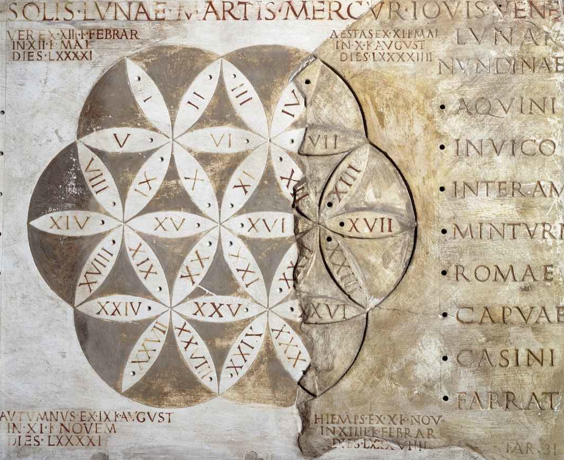
Nundinal calendar, Rome. The ancient Etruscans developed an eight-day market week, known as the nundinal cycle, around the eighth or seventh century BC.
In fact, of the six such widely reverberating innovations that Johnson highlights, the one sparked by Galileo is the most fascinating because it captures so many dimensions of our eternal and eternally bedeviled relationship with time — ourastoundingly elastic perception of it, the way it dictates our internal rhythmsand our creative routines, its role in free will, and much more. Johnson tells an absorbing origin story the way only he can:
Legend has it that in 1583, a nineteen-year-old student at the University of Pisa attended prayers at the cathedral and, while daydreaming in the pews, noticed one of the altar lamps swaying back and forth. While his companions dutifully recited the Nicene Creed around him, the student became almost hypnotized by the lamp’s regular motion. No matter how large the arc, the lamp appeared to take the same amount of time to swing back and forth. As the arc decreased in length, the speed of the lamp decreased as well. To confirm his observations, the student measured the lamp’s swing against the only reliable clock he could find: his own pulse.
That teenager, of course, was Galileo. Johnson explains the significance of that mythic moment:
That Galileo was daydreaming about time and rhythm shouldn’t surprise us: his father was a music theorist and played the lute. In the middle of the sixteenth century, playing music would have been one of the most temporally precise activities in everyday culture. (The musical term “tempo” comes from the Italian word for time.) But machines that could keep a reliable beat didn’t exist in Galileo’s age; the metronome wouldn’t be invented for another few centuries. So watching the altar lamp sway back and forth with such regularity planted the seed of an idea in Galileo’s young mind. As is so often the case, however, it would take decades before the seed would blossom into something useful.
Indeed, Galileo’s mass experience stands as a spectacular testament to the usefulness of useless knowledge. Over the next two decades, he busied himself with becoming a professor of mathematics, tinkering with telescopes, and, as Johnson aptly puts it, “more or less inventing modern science” (andwithstanding the pushback). And yet he kept the image of that swinging altar lamp on the back-burner of his mind. Eventually, as he grew increasingly enchanted with motion and dynamics, he decided to build a pendulum that would simulate what he had observed that distant day at the cathedral. His discovery confirmed his intuition — what determined the time it took the pendulum to swing wasn’t the size of the arc or the weight of the object, but merely the length of the string. Johnson cites Galileo’s excited letter to his peer Giovanni Battista Baliani:
The marvelous property of the pendulum is that it makes all its vibrations, large or small, in equal times.
In our present age of productivity, when our entire lives depend on accurate timekeeping — from our daily routines to our conference calls to financial markets and flights — it’s hard to imagine just how groundbreaking and downright miraculous the concept of measuring time accurately was in 16th-century Italy. And yet that’s precisely what it was — Italian towns then, Johnson points out, had clunky mechanical clocks that reflected a loose estimation of time, often losing twenty minutes a day, and had to be constantly corrected by sundial readings. Johnson writes:
The state of the art in timekeeping technology was challenged by just staying accurate on the scale of days. The idea of a timepiece that might be accurate to the second was preposterous.Preposterous, and seemingly unnecessary. Just like Frederic Tudor’s ice trade, it was an innovation that had no natural market. You couldn’t keep accurate time in the middle of the sixteenth century, but no one really noticed, because there was no need for split-second accuracy. There were no buses to catch, or TV shows to watch, or conference calls to join. If you knew roughly what hour of the day it was, you could get by just fine.
This is where the wings of the hummingbird begin to flutter: The real tipping point in accuracy, Johnson points out in a twist, “would emerge not from the calendar but from the map” — which makes sense given our long history of using cartography to measure time. He explains:
This was the first great age of global navigation, after all. Inspired by Columbus, ships were sailing to the Far East and the newly discovered Americas, with vast fortunes awaiting those who navigated the oceans successfully. (And almost certain death awaiting those who got lost.) But sailors lacked any way to determine longitude at sea. Latitude you could gauge just by looking up at the sky. But before modern navigation technology, the only way to figure out a ship’s longitude involved two clocks. One clock was set to the exact time of your origin point (assuming you knew the longitude of that location). The other clock recorded the current time at your location at sea. The difference between the two times told you your longitudinal position: every four minutes of difference translated to one degree of longitude, or sixty-eight miles at the equator.In clear weather, you could easily reset the ship clock through accurate readings of the sun’s position. The problem was the home-port clock. With timekeeping technology losing or gaining up to twenty minutes a day, it was practically useless on day two of the journey.
This was an era when European royalty offered handsome bounties for specific innovations — the then-version of venture capital — incentivizing such scientific breakthroughs as Maria Mitchell’s comet discoveries and Johannes Hevelius’s star catalog. As the need to solve the navigation problem grew in urgency, the rewards offered for a solution grew in magnitude — and this was what resurfaced Galileo’s teenage vision for “equal time” all those years later. Johnson describes Galileo’s journey as a superb example of the “slow churn” of creativity, the value of cross-pollinating disciplines, and the importance ofplaying “the long game”:
[Galileo's] astronomical observations had suggested that the regular eclipses of Jupiter’s moons might be useful for navigators keeping time at sea, but the method he devised was too complicated (and not as accurate as he had hoped). And so he returned, one last time, to the pendulum.Fifty-eight years in the making, his slow hunch about the pendulum’s “magical property” had finally begun to take shape. The idea lay at the intersection point of multiple disciplines and interests: Galileo’s memory of the altar lamp, his studies of motion and the moons of Jupiter, the rise of a global shipping industry, and its new demand for clocks that would be accurate to the second. Physics, astronomy, maritime navigation, and the daydreams of a college student: all these different strains converged in Galileo’s mind. Aided by his son, he began drawing up plans for the first pendulum clock.
There is something so poetic about Galileo inventing split-second time for the public on a private scale of decades.
Over the century that followed, the pendulum clock, a hundred times more accurate than any preceding technology, became a staple of European life and forever changed our relationship with time. But the hummingbird’s wings continued to flap — accurate timekeeping became the imperceptible heartbeat beneath all technology of the Industrial Revolution, from scheduling the division of labor in factories to keeping steam-powered locomotives running on time. It was the invisible hand of the clock that first moved the market — a move toward unanticipated innovations in other fields. Without clocks, Johnson argues, the Industrial Revolution may have never taken off — or “at the very least, have taken much longer to reach escape velocity.” He explains:
Accurate clocks, thanks to their unrivaled ability to determine longitude at sea, greatly reduced the risks of global shipping networks, which gave the first industrialists a constant supply of raw materials and access to overseas markets. In the late 1600s and early 1700s, the most reliable watches in the world were manufactured in England, which created a pool of expertise with fine-tool manufacture that would prove to be incredibly handy when the demands of industrial innovation arrived, just as the glassmaking expertise producing spectacles opened the door for telescopes and microscopes. The watchmakers were the advance guard of what would become industrial engineering.
But the most radical innovation of clock time was the emergence of the new working day. Up until that point, people divided their days not into modular abstract units — after all, what is an hour? — but into a fluid series of activities:
Instead of fifteen minutes, time was described as how long it would take to milk the cow or nail soles to a new pair of shoes. Instead of being paid by the hour, craftsmen were conventionally paid by the piece produced — what was commonly called “taken-work” — and their daily schedules were almost comically unregulated.
Rather, they were self-regulated by shifting factors like the worker’s health or mood, the weather, and the available daylight during that particular season. The emergence of factories demanded a reliable, predictable industrial workforce, which in turn called for fundamentally reframing the human perception of time. In one particularly pause-giving parenthetical aside, Johnson writes:
The lovely double entendre of “punching the clock” would have been meaningless to anyone born before 1700.
And yet, as with most innovations, the industrialization of time came with a dark side — one Bertrand Russell so eloquently lamented in the 1920s when he asked: “What will be the good of the conquest of leisure and health, if no one remembers how to use them?” Johnson writes:
The natural rhythms of tasks and leisure had to be forcibly replaced with an abstract grid. When you spend your whole life inside that grid, it seems like second nature, but when you are experiencing it for the first time, as the laborers of industrial England did in the second half of the eighteenth century, it arrives as a shock to the system. Timepieces were not just tools to help you coordinate the day’s events, but something more ominous: the “deadly statistical clock,” in Dickens’s Hard Times, “which measured every second with a beat like a rap upon a coffin lid.”[...]To be a Romantic at the turn of the nineteenth century was in part to break from the growing tyranny of clock time: to sleep late, ramble aimlessly through the city, refuse to live by the “statistical clocks” that governed economic life… The time discipline of the pendulum clock took the informal flow of experience and nailed it to a mathematical grid. If time is a river, the pendulum clock turned it into a canal of evenly spaced locks, engineered for the rhythms of industry.
Johnson goes on to trace the hummingbird flutterings to the emergence of pocket watches, the democratization of time through the implementation of Standard Time, and the invention of the first quartz clock in 1928, which boasted the unprecedented accuracy of losing or gaining only one thousandth of a second per day. He observes the most notable feature of these leaps and bounds:
One of the strangest properties of the measurement of time is that it doesn’t belong neatly to a single scientific discipline. In fact, each leap forward in our ability to measure time has involved a handoff from one discipline to another. The shift from sundials to pendulum clocks relied on a shift from astronomy to dynamics, the physics of motion. The next revolution in time would depend on electromechanics. With each revolution, though, the general pattern remained the same: scientists discover some natural phenomenon that displays the propensity for keeping “equal time” that Galileo had observed in the altar lamps, and before long a wave of inventors and engineers begin using that new tempo to synchronize their devices.
But the most groundbreaking effect of the quartz clock — the most unpredictable manifestation of the hummingbird effect in the story of time — was that it gave rise to modern computing and the Information Age. Johnson writes:
Computer chips are masters of time discipline… Instead of thousands of operations per minute, the microprocessor is executing billions of calculations per second, while shuffling information in and out of other microchips on the circuit board. Those operations are all coordinated by a master clock, now almost without exception made of quartz… A modern computer is the assemblage of many different technologies and modes of knowledge: the symbolic logic of programming languages, the electrical engineering of the circuit board, the visual language of interface design. But without the microsecond accuracy of a quartz clock, modern computers would be useless.
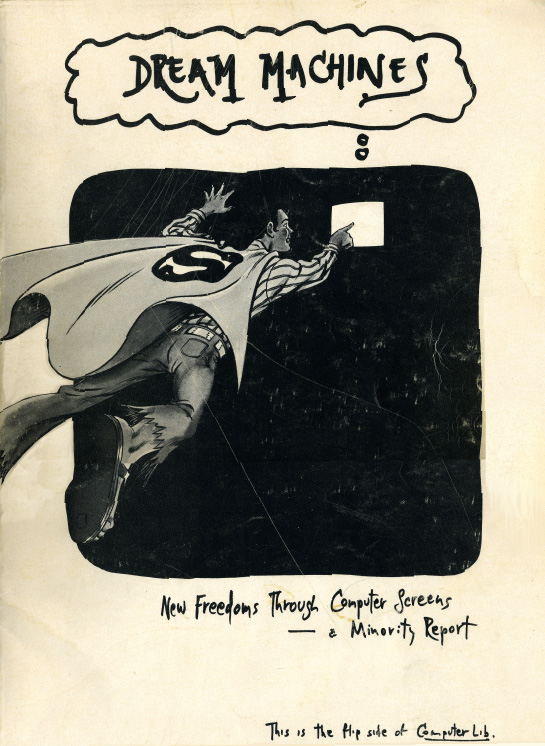
Theodor Nelson's pioneering 1974 book 'Computer Lib | Dream Machines,' an exploration of the creative potential of computer networks, from '100 Ideas that Changed the Web' (Click image for more)
But as is often the case given the “thoroughly conscious ignorance” by which science progresses, new frontiers of knowledge only exposed what is yet to be reached. With the invention of the quartz clock also came the realization that the length of the day wasn’t as reliable as previously thought and the earth’s rotation wasn’t the most accurate tool for reaching Galileo’s measurement ideal of “equal time.” As Johnson puts it, “quartz let us ‘see’ that the seemingly equal times of a solar day weren’t nearly as equal as we had assumed” — the fact that a block of vibrating sand did a better job of keeping time than the sun and the earth, celebrated for centuries as the ultimate timekeepers, became the ultimate “deathblow to the pre-Copernican universe.”
What accurate timekeeping needed, ever since Galileo’s contemplation of the pendulum, was something that oscillated in the most consistent rhythm possible — and that’s what Niels Bohr and Werner Heisenberg’s discovery of the atom in the beginning of the twentieth century finally provided. With its rhythmically spinning electrons, the smallest chemical unit became the greatest and most consistent oscillator ever known. When the first atomic clocks were built in the 1950s, they introduced a groundbreaking standard of accuracy, measuring time down to the nanosecond, thousandfold better than the quartz clock’s microseconds.
Half a century later, this unprecedented precision is something we’ve come to take for granted — and yet it continues to underpin our lives with a layer of imperceptible magic. In one example, Johnson brings us full-circle to the relationship between timekeeping and map navigation where Galileo began:
Every time you glance down at your smartphone to check your location, you are unwittingly consulting a network of twenty-four atomic clocks housed in satellites in low-earth orbit above you. Those satellites are sending out the most elemental of signals, again and again, in perpetuity: the time is 11:48:25.084738 . . . the time is 11:48:25.084739. . . . When your phone tries to figure out its location, it pulls down at least three of these time stamps from satellites, each reporting a slightly different time thanks to the duration it takes the signal to travel from satellite to the GPS receiver in your hand. A satellite reporting a later time is closer than one reporting an earlier time. Since the satellites have perfectly predictable locations, the phone can calculate its exact position by triangulating among the three different time stamps. Like the naval navigators of the eighteenth century, GPS determines your location by comparing clocks. This is in fact one of the recurring stories of the history of the clock: each new advance in timekeeping enables a corresponding advance in our mastery of geography — from ships, to railroads, to air traffic, to GPS. It’s an idea that Einstein would have appreciated: measuring time turns out to be key to measuring space.
Therein lies the remarkable power and reach of the hummingbird effect, which Johnson condenses into an elegant concluding reflection:
Embedded in your ability to tell the time is the understanding of how electrons circulate within cesium atoms; the knowledge of how to send microwave signals from satellites and how to measure the exact speed with which they travel; the ability to position satellites in reliable orbits above the earth, and of course the actual rocket science needed to get them off the ground; the ability to trigger steady vibrations in a block of silicon dioxide — not to mention all the advances in computation and microelectronics and network science necessary to process and represent that information on your phone. You don’t need to know any of these things to tell the time now, but that’s the way progress works: the more we build up these vast repositories of scientific and technological understanding, the more we conceal them. Your mind is silently assisted by all that knowledge each time you check your phone to see what time it is, but the knowledge itself is hidden from view. That is a great convenience, of course, but it can obscure just how far we’ve come since Galileo’s altar-lamp daydreams in the Duomo of Pisa.
But perhaps the strangest thing about time is how each leap of innovation further polarized the scales on which it played out. As in the case of Galileo, who took six decades to master the minute, the same breakthroughs that gave atomic time its trailblazing accuracy also gave us radiation and radiometric dating, which was essential in debunking the biblical myth and proving that earth’s age was in the billions, not thousands, of years.

5,068-year-old bristlecone pine from Rachel Sussman's 'The Oldest Living Things in the World' (Click image for more)
Pointing to the Long Now Foundation’s quest to bury a clock that ticks once every 10,000 years beneath some of the oldest living pines in the world — an effort to extract us from the toxic grip of short-termism and, in the words of Long Now founder Kevin Kelly, nudge us to think about “generational-scale questions and projects” — Johnson ends with a wonderfully poetic reflection:
This is the strange paradox of time in the atomic age: we live in ever shorter increments, guided by clocks that tick invisibly with immaculate precision; we have short attention spans and have surrendered our natural rhythms to the abstract grid of clock time. And yet simultaneously, we have the capacity to imagine and record histories that are thousands or millions of years old, to trace chains of cause and effect that span dozens of generations. We can wonder what time it is and glance down at our phone and get an answer that is accurate to the split-second, but we can also appreciate that the answer was, in a sense, five hundred years in the making: from Galileo’s altar lamp to Niels Bohr’s cesium, from the chronometer to Sputnik. Compared to an ordinary human being from Galileo’s age, our time horizons have expanded in both directions: from the microsecond to the millennium.
In the remainder of How We Got to Now, a remarkable and perspective-shifting masterwork in its entirety, Johnson goes on to examine with equal dimension and rigor the workings of the hummingbird effect through the invention and evolution of such concepts as sound, light, glass, sanitation, and cooling.
For more on the mysteries of time, see these seven revelatory perspectives for a variety of fields, then revisit the curious psychology of why time slows down when you’re afraid, speeds up as you age, and gets warped while you’re on vacation.
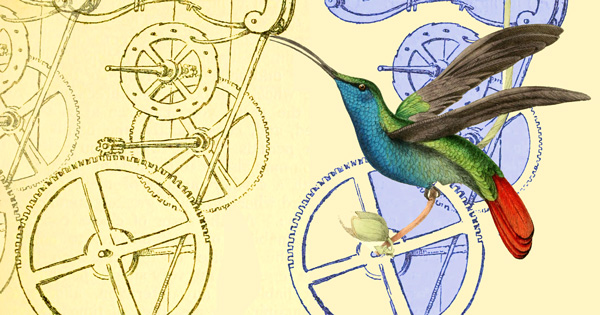

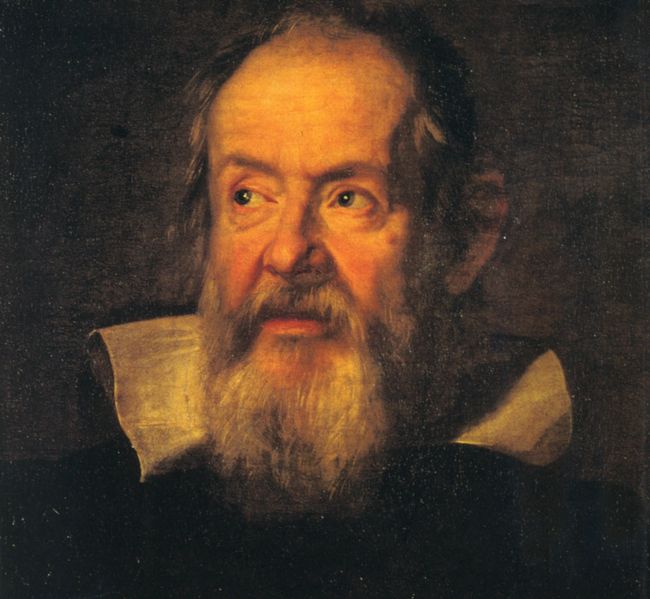

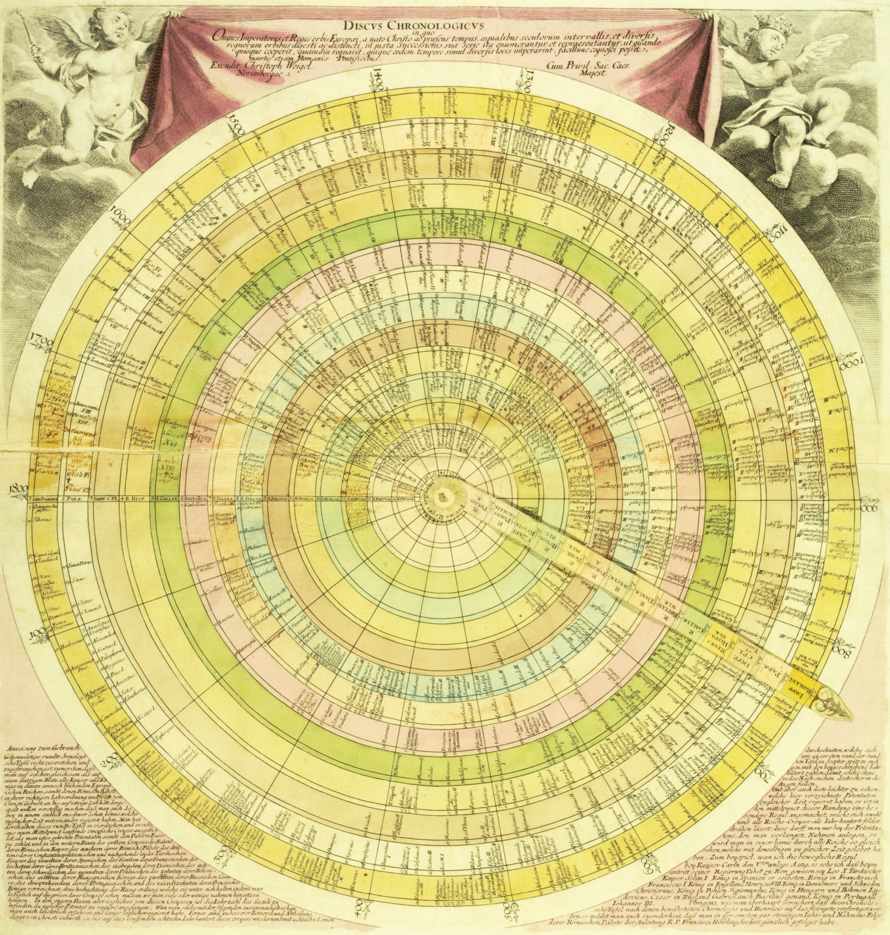
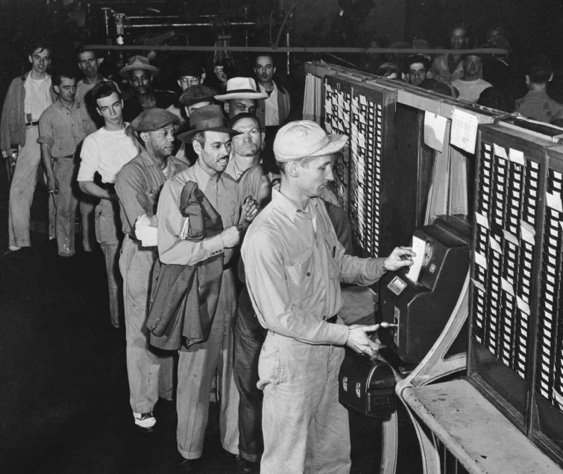
No comments:
Post a Comment